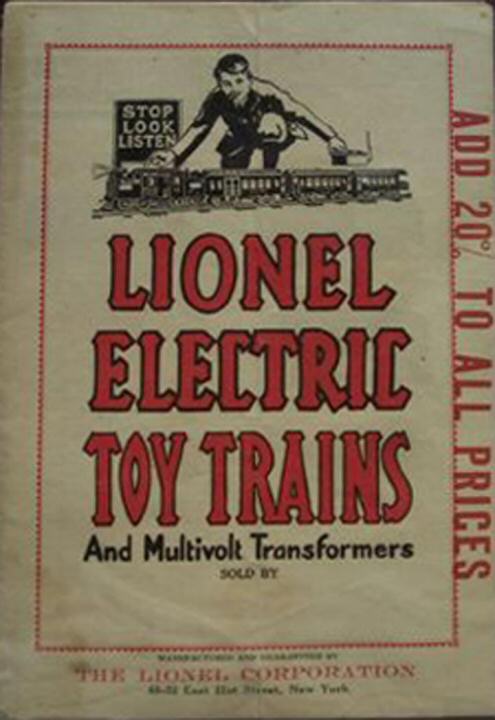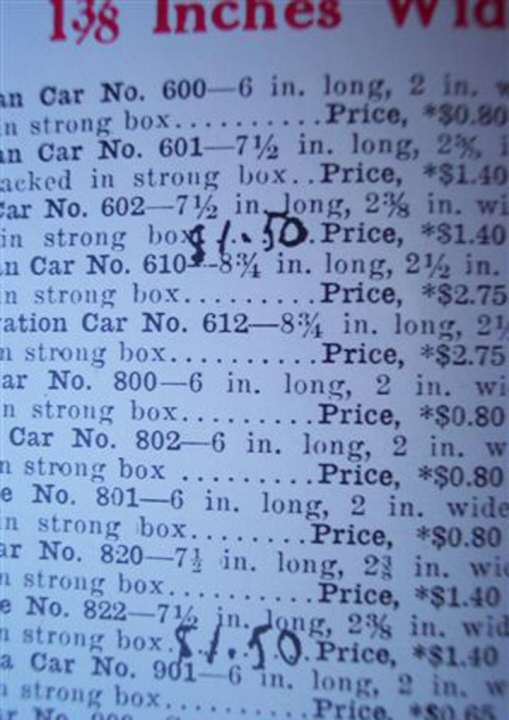The First Lionel Dealer Advance Catalog?
By Leo Schoeck
One of the real joys of collecting is the discovery and acquisition of a rare and previously unreported item. Perhaps the best example of this is the finding of a Lionel 1900 catalog by Paul Wasserman, the details of which he generously shared with his fellow TCA members.
It is the sort of feeling I got when I saw an eBay listing of a 1918 Lionel catalog with a strange imprint on the right margin of its cover page.
Why on earth would anyone want to issue a catalog that shouts to the customers, ALL PRICES ARE 20% HIGHER? Certainly not that marketing genius Joshua Cowen.
So what was this strange catalog? A fake; a dealer’s markup; or something else?
I compared the seller’s photos with my reproduction copies of the period and it appeared to match the 1918 Consumer folder.
However, since I could not read the fine print, I couldn’t be certain, but it seemed to have something to do with the World War I inflation and the New York Printer’s strike.
Convincing myself that this catalog had to be even rarer than a regular catalog of this vintage, I decided to go for it. I got it for a lower price than I expected, probably due to the uncertainty of its origin and the obvious tears and crease separations.
On this latter point, let me digress.
As I guess most people in the hobby already know, archival paper documents should never be repaired with scotch tape. Such repairs are very obvious and will, over-time, discolor and make things worse. Tears in valuable papers should only be repaired with archival quality mending tissue, such as that made by Lineco Inc., Holyoke, MA.
Archival tissue repairs when properly done are almost invisible; will not discolor with age; and will better preserve documents for posterity. Now back to my story.
Upon receiving the catalog, I determined that it matched neither the 1918 nor 1919 Consumer Folder repro catalogs, but was, in fact, an original 1919 Consumer Folder.
Following are some price comparisons:
| Outfit No. 34 | US EAST | US WEST | CANADA |
| GB 1918 Catalog Repro | $15.00 | $18.00 | $22.50 |
| Feb. 1919 Price Sheet | $15.50 | $19.00 | $23.75 |
| Subject Catalog | $17.50 | $21.00 | $26.25 |
| Early 1920 “BOYS” Repro | $21.45 | $25.30 | $32.15 |
| Subject Catalog + 20% | $25.74 | $30.36 | $38.58 |
| 1920 Consumer Folder (orig.) | $25.00 | $30.00 | $37.50 |
| Feb. 1921 Price Sheet | $22.50 | $27.00 | $33.25 |
| Outfit No. 420 | |||
| GB 1918 Catalog Repro | $35.00 | $45.00 | $52.50 |
| Feb. 1919 Price Sheet | $37.50 | $46.00 | $57.50 |
| Subject Catalog | $42.50 | $51.00 | $63.75 |
| Early 1920 “BOYS” Repro | $51.70 | $63.80 | $77.55 |
| Subject Catalog + 20% | $62.04 | $76.56 | $93.06 |
| 1920 Consumer Folder (orig.) | $62.50 | $75.00 | $93.75 |
| Feb. 1921 Price Sheet | $54.50 | $65.00 | $81.75 |
| Outfit No. 421 | |||
| GB 1918 Catalog Repro | $42.50 | $52.50 | $63.75 |
| Feb. 1919 Price Sheet | $45.75 | $57.00 | $68.75 |
| Subject Catalog | $52.50 | $63.00 | $78.75 |
| Early 1920 “BOYS” Repro | $63.80 | $75.90 | $95.70 |
| Subject Catalog + 20% | $76.56 | $91.08 | $114.84 |
| 1920 Consumer Folder (orig.) | $75.00 | $90.00 | $112.50 |
| Feb. 1921 Price Sheet | $75.00 | $90.00 | $112.50 |
The promised but delayed regular 1920 Consumer Catalog was published without listed retail prices for obvious reasons. It follows that a 1920 price sheet must have been issued but I am unaware of any in existence. A dated 1920 price sheet would permit a more accurate sequencing of the issue date for these catalogs. Also of note is that by the beginning of 1921, the post World War I inflation had been brought under control, and Lionel was even able to reduce some prices.
As can be seen, the original 1919 Consumer Folder imprinted with the 20% price increase notice brings the retail prices in line with the 1920 Consumer Folder issue. My theory is, in light of double digit inflation and the inability to print a new catalog at the time, Lionel utilized left over 1919 Consumer Folders to provide dealers with advance information as to the 1920 product offerings and retail prices. In this sense, it would classify this as an advance dealer catalog and very rare. As far as I know, the first true advance dealer catalog did not come along until 1930.
As a byproduct of this analysis, some interesting questions are raised. Why are the 1919 Greenberg repro catalog prices higher than those listed in the 1919 Price Sheet? And why, in view of the inflation taking place, are the 1919 repro prices identical to that of the 1920 “BOYS” repro? It should be noted that both of the 1919 and 1920 Greenberg versions have identical handwritten $1.50 price notations for Mail Car No. 602 and Caboose No. 822
Indeed, the Vagell 1920 repro shows signs of these same notations being erased. One can only conclude that, except for the “MORE THAN A TOY” panel, a 1920 original was used for the 1919 repro. In all these past years, has no one noticed this?
I believe the subject catalog is a true 1919 issue and this can be proven by a comparison of the prices in an original 1919 Consumer Folder w/o the imprint.
Any volunteers?







